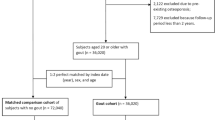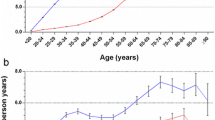Abstract
The aim of the study was to investigate the longitudinal transition trajectory of gout and its comorbidities in male patients with gout in different age groups. A total of 3973 male patients who received a new diagnosis of gouty arthritis were identified from the Taiwan Longitudinal Health Insurance Database and divided into two age cohorts (<50 and ≥50 years). Each patient was individually followed from 2000 to 2009 to identify associated comorbidities, namely hypertension, hypercholesterolemia, diabetes mellitus, cardiovascular diseases, and chronic kidney disease. Two outcome measurements of stroke and all-cause cancer were further identified until 2010. The transition trajectory was divided into the following five phenotype groups: persistent hypertension combined with a high prevalence of various gout-related comorbidities, persistent hypercholesterolemia combined with a moderate prevalence of various gout-related comorbidities, persistent low prevalence of various gout-related comorbidities, moderate to high prevalence of various gout-related comorbidities, and low to high prevalence of various gout-related comorbidities. Although the younger and older patients had a similar longitudinal transition trajectory of gout-related comorbidities, the older patients had a higher 10-year likelihood of transition from a low or moderate to a high prevalence of various gout-related comorbidities. In addition, the incidences of stroke and all-cause cancer were higher in the groups with high and moderate to high prevalences of various gout-related comorbidities than in the other groups. The occurrence of gouty arthritis in different life stages can cause cluster effects involving varying degrees of comorbidities over time. The findings of the current study can provide additional knowledge and increase clinical awareness regarding the early assessment and management of gout-related comorbidities in clinical practice.



Similar content being viewed by others
References
Chuang SY, Lee SC, Hsieh YT, Pan WH (2011) Trends in hyperuricemia and gout prevalence: Nutrition and Health Survey in Taiwan from 1993–1996 to 2005–2008. Asia Pac J Clin Nutr 20:301–308
Johnson RJ (2015) Why focus on uric acid? Curr Med Res Opin 31:3–7
Zhu Y, Pandya BJ, Choi HK (2011) Prevalence of gout and hyperuricemia in the US general population: the National Health and Nutrition Examination Survey 2007–2008. Arthritis Rheum 63:3136–3141
Grayson PC, Kim SY, LaValley M, Choi HK (2011) Hyperuricemia and incident hypertension: a systematic review and meta-analysis. Arthritis Care Res 63:102–110
Kim SY, Guevara JP, Kim KM, Choi HK, Heitjan DF, Albert DA (2010) Hyperuricemia and coronary heart disease: a systematic review and meta-analysis. Arthritis Care Res 62:170–180
Mancia G, Grassi G, Borghi C (2015) Hyperuricemia, urate deposition and the association with hypertension. Curr Med Res Opin 31(Suppl 2):15–19
Brook RA, Forsythe A, Smeeding JE, Lawrence Edwards N (2010) Chronic gout: epidemiology, disease progression, treatment and disease burden. Curr Med Res Opin 26:2813–2821
Robinson PC, Merriman TR, Herbison P, Highton J (2012) Hospital admissions associated with gout and their comorbidities in New Zealand and England 1999–2009. Rheumatology 52:118–126
Singh JA, Strand V (2008) Gout is associated with more comorbidities, poorer health-related quality of life and higher healthcare utilisation in US veterans. Ann Rheum Dis 67:1310–1316
Richette P, Clerson P, Perissin L, Flipo RM, Bardin T (2013) Revisiting comorbidities in gout: a cluster analysis. Ann Rheum Dis 74:142–147
Hildrum B, Mykletun A, Hole T, Midthjell K, Dahl AA (2007) Age-specific prevalence of the metabolic syndrome defined by the International Diabetes Federation and the National Cholesterol Education Program: the Norwegian HUNT 2 study. BMC Public Health 7:220
Jousilahti P, Vartiainen E, Tuomilehto J, Puska P (1999) Sex, age, cardiovascular risk factors, and coronary heart disease: a prospective follow-up study of 14 786 middle-aged men and women in Finland. Circulation 99:1165–1172
Kim SY, De Vera MA, Choi HK (2008) Gout and mortality. Clin Exp Rheumatol 26(5 Suppl 51):S115–S119
Krishnan E, Lingala B, Bhalla V (2012) Low-level lead exposure and the prevalence of gout: an observational study. Ann Intern Med 157:233–241
Rashid N, Levy GD, Wu YL, Zheng C, Koblick R, Cheetham TC (2015) Patient and clinical characteristics associated with gout flares in an integrated healthcare system. Rheumatol Int 35:1799–1807
DeMarco MA, Maynard JW, Huizinga MM, Baer AN, Kottgen A, Gelber AC et al (2011) Obesity and younger age at gout onset in a community-based cohort. Arthritis Care Res 63:1108–1114
Kumar S, Gupta R, Suppiah R (2012) Gout in women: differences in risk factors in young and older women. NZ Med J 125:39–45
Seminog OO, Goldacre MJ (2013) Gout as a risk factor for myocardial infarction and stroke in England: evidence from record linkage studies. Rheumatology 52:2251–2259
Hsing AW, Ioannidis JP (2015) Nationwide population science: lessons from the Taiwan National Health Insurance Research Database. JAMA Intern Med 175:1527–1529
Wu CY, Chen YJ, Ho HJ, Hsu YC, Kuo KN, Wu MS et al (2012) Association between nucleoside analogues and risk of hepatitis B virus-related hepatocellular carcinoma recurrence following liver resection. JAMA 308:1906–1914
Harris MD, Siegel LB, Alloway JA (1999) Gout and hyperuricemia. Am Fam Phys 59:925–934
Collins LM, Lanza S (2010) Latent class and latent transition analysis with applications in the social, behavioral, and health sciences. Wiley, Hoboken
Landau S, Harris V, Burn DJ, Hindle JV, Hurt CS, Samuel M et al (2016) Anxiety and anxious-depression in Parkinson’s disease over a 4-year period: a latent transition analysis. Psychol Med 46:657–667
Soto-Ramirez N, Ziyab AH, Karmaus W, Zhang H, Kurukulaaratchy RJ, Ewart S et al (2013) Epidemiologic methods of assessing asthma and wheezing episodes in longitudinal studies: measures of change and stability. J Epidemiol 23:399–410
Mathur C, Stigler MH, Erickson DJ, Perry CL, Forster JL (2014) Transitions in smoking behavior during emerging adulthood: a longitudinal analysis of the effect of home smoking bans. Am J Public Health 104:715–720
Maxwell AJ, Bruinsma KA (2001) Uric acid is closely linked to vascular nitric oxide activity. Evidence for mechanism of association with cardiovascular disease. J Am Coll Cardiol 38:1850–1858
Doehner W, Landmesser U (2011) Xanthine oxidase and uric acid in cardiovascular disease: clinical impact and therapeutic options. Semin Nephrol 31:433–440
Puzserova A, Bernatova I (2016) Blood pressure regulation in stress: focus on nitric oxide-dependent mechanisms. Physiol Res 65(Supplementum 3):S309–S342
Honing ML, Morrison PJ, Banga JD, Stroes ES, Rabelink TJ (1998) Nitric oxide availability in diabetes mellitus. Diabetes Metab Rev 14:241–249
Feron O, Dessy C, Moniotte S, Desager JP, Balligand JL (1999) Hypercholesterolemia decreases nitric oxide production by promoting the interaction of caveolin and endothelial nitric oxide synthase. J Clin Invest 103:897–905
Kruzliak P, Maruyama J, Maruyama K (2014) Role of nitric oxide in pathophysiology and treatment of pulmonary hypertension. Vitam Horm 96:407–424
Perez-Ruiz F, Becker MA (2015) Inflammation: a possible mechanism for a causative role of hyperuricemia/gout in cardiovascular disease. Curr Med Res Opin 31(Suppl 2):9–14
Chen CJ, Yen JH, Chang SJ (2014) Gout patients have an increased risk of developing most cancers, especially urological cancers. Scand J Rheumatol 43:385–390
Kuo CF, Luo SF, See LC, Chou IJ, Fang YF, Yu KH (2012) Increased risk of cancer among gout patients: a nationwide population study. Joint Bone Spine 79:375–378
Fini MA, Elias A, Johnson RJ, Wright RM (2012) Contribution of uric acid to cancer risk, recurrence, and mortality. Clin Trans Med 1:16
Braun S, Bitton-Worms K, LeRoith D (2011) The link between the metabolic syndrome and cancer. Int J Biol Sci 7:1003–1015
You J, Liu WY, Zhu GQ, Wang OC, Ma RM, Huang GQ et al (2015) Metabolic syndrome contributes to an increased recurrence risk of non-metastatic colorectal cancer. Oncotarget 6:19880–19890
Orengo JM, Leliwa-Sytek A, Evans JE, Evans B, van de Hoef D, Nyako M et al (2009) Uric acid is a mediator of the Plasmodium falciparum-induced inflammatory response. PLoS One 4:e5194
Lin CC, Lai MS, Syu CY, Chang SC, Tseng FY (2005) Accuracy of diabetes diagnosis in health insurance claims data in Taiwan. JFMA 104:157–163
Hsieh CY, Chen CH, Li CY, Lai ML (2015) Validating the diagnosis of acute ischemic stroke in a National Health Insurance claims database. JFMA 114:254–259
Cheng CL, Lee CH, Chen PS, Li YH, Lin SJ, Yang YH (2014) Validation of acute myocardial infarction cases in the national health insurance research database in Taiwan. J Epidemiol 24:500–507
Hung YN, Kadziola Z, Brnabic AJ, Yeh JF, Fuh JL, Hwang JP et al (2016) The epidemiology and burden of Alzheimer’s disease in Taiwan utilizing data from the National Health Insurance Research Database. Clinicoecon Outcomes Res 8:387–395
Hsu CC, Wang H, Hsu YH, Chuang SY, Huang YW, Chang YK et al (2015) Use of nonsteroidal anti-inflammatory drugs and risk of chronic kidney disease in subjects with hypertension: nationwide longitudinal cohort study. Hypertension 66:524–533
Abeles AM (2015) Hyperuricemia, gout, and cardiovascular disease: an update. Curr Rheumatol Rep 17:13
Akkineni R, Tapp S, Tosteson AN, Lee A, Miller KL, Choi HK et al (2014) Treatment of asymptomatic hyperuricemia and prevention of vascular disease: a decision analytic approach. J Rheumatol 41:739–748
Author information
Authors and Affiliations
Corresponding author
Ethics declarations
Conflict of interest
The authors report no conflicts of interest.
Ethical standard
The Institutional Review Board of National Taiwan University approved this study (201403ES034). The NHIRD contains data that have been deidentified for research purposes. The confidentiality of the data is maintained by the NHRI, and written consent was not required from patients for this study.
Additional information
Chien-Fang Huang and Ju-Chi Liu have contributed equally to this article.
Rights and permissions
About this article
Cite this article
Huang, CF., Liu, JC., Huang, HC. et al. Longitudinal transition trajectory of gouty arthritis and its comorbidities: a population-based study. Rheumatol Int 37, 313–322 (2017). https://doi.org/10.1007/s00296-016-3634-9
Received:
Accepted:
Published:
Issue Date:
DOI: https://doi.org/10.1007/s00296-016-3634-9




